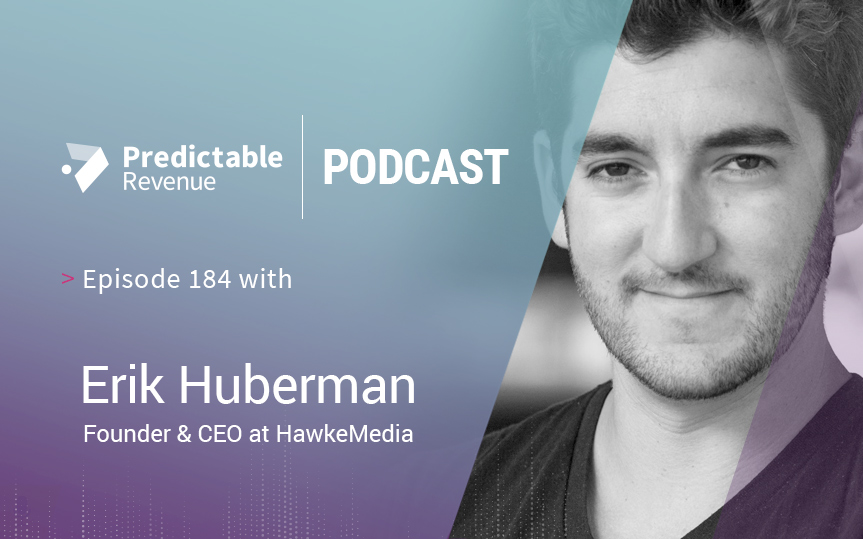How to Create a Value Proposition

When Erik Huberman, a recent guest on the Predictable Revenue Podcast, was in college studying business management, he laughed at the idea of a marketing major. “What does marketing mean?” he asked himself. “You draw pictures and come up with funny slogans? What do you do all day?” But his career would prove, time and time again, that marketing was key to the growth of each one of his businesses, before he finally decided to jump into the marketing world with both feet.
Erik’s first company was an eCommerce company called Fame Wizard that provided 1 on 1 coaching for musicians. When he and his co-founders launched this company, they found a hack on craigslist where they were able to post in the gigs section of the website that they could help people get gigs, and they were flooded with leads hungry for exactly that.
At the time, Erik didn’t think of this as marketing, but he was beginning to understand that being where your customers are, getting in front of them with a value proposition that resonates with them, and being cost-effective about it was the way to drive business. He soon hired a CEO to take over Fame Wizard and consecutively built and sold 2 fashion subscription eCommerce websites, and in doing so, it became apparent that he didn’t simply understand the concept of marketing, but he had a knack for it too.
THE MARKETING ECOSYSTEM SUCKS
The serial entrepreneur built a reputation for himself of knowing how to build and grow brands, and he started consulting and advising brands, big and small, on how to drive revenue growth using marketing. He worked with Redbull, Verizon, Eddy Bauer, HP, and a bunch of startups.
Over time, he dealt with the same challenges over and over again that he had dealt with when building his own businesses, which highlighted for him a global problem: when it comes time to execute on a growth strategy, the marketing ecosystem sucks.
According to Erik, you have 2 options if you want to grow through marketing. You can hire in-house, or hire an agency. The problem with hiring in-house is that most brands don’t have the capital to attract the best marketers in the industry, and 99% of the remaining marketers out there don’t actually know anything about how to build a brand or build a business through marketing.
Even if you can afford the best in-house marketers, you end up operating in a vacuum without checks and balances. A recent example of this is the Kendall Jenner Pepsi ad – a colorful, energetic, star-studded commercial that is, at best, tone-deaf, and, at worst, overtly racist.
The problem with agencies is that, like most marketers, 99% of them don’t actually know how to grow a brand through marketing. People seem to have career trajectories that take them to all sorts of businesses in all sorts of roles and after some degree of success, they think they have marketing expertise to impart to the world. Some of these people are good salespeople and convince companies to give them their money, but, more often than not, that money gets lost.
The minority of remaining good agencies quickly go upmarket and want long contracts, high minimums, and end up inaccessible to the average company. Either way – as Erik puts it, “if you’re not a Fortune 1000 or a really sexy startup,” you don’t have access to great marketing.
HAWKE MEDIA
The problem in the marketing ecosystem was the one Erik wanted to solve. So, with the mission of making great marketing accessible to everyone, he hired a small swat team of sharp marketers, each with their own area of expertise, from Facebook to email, to web design, and Hawke Media was born.
They offer a la carte, month to month, affordable packages so companies can spin up exactly what they need, when they need it. 6 years and 170 full-time employees later, they still follow the same model.
Throughout Erik’s many successes building and selling companies, consulting for huge brands, and working with countless others and the Hawke Media team, Erik has enjoyed the fruits of a successful marketing strategy time and time again. And keystone to it all is the perfect value proposition.
THE WOM MULTIPLIER
Erik views the value proposition as a distilled elevator pitch. People don’t have time to listen to the 30-second elevator pitch anymore so you instead need to come up with one sentence that clearly articulates the value of your company while piquing people’s interest and leaving them wanting to know more. The purpose of this phrase is to drive word of mouth.
Think about it in degrees of connection. This phrase isn’t for the first person you talk to about your business, the first person you’re advertising to, the person your salesperson is talking to. In those scenarios, you might actually have the 30 seconds to give your pitch. It’s for the 2nd-degree connection.
Word of mouth is still the biggest driver of business, so make it easy to pass along your value by creating one sentence that people can regurgitate to their connections on why they should call you.
FINDING THE SENTENCE
1) Come up with the pitch
Your pitch must be a combination of informative and intriguing. Start with your 30-second elevator pitch. What is the value of your company? What is the core of what you’re offering? What problem are you solving for people? Your product or service can be a want, need, or aspiration for people, and the pitch needs to speak to how it helps them achieve that.
2) Distill it
Make your pitch concise – just 5-7 words. A lot of us struggle to distill our value, especially if we are founders and the company is our baby. But if someone asks you “one sentence: what do you do?” and you can’t answer, you’re losing out on the power of word of mouth.
3) Test it
Get tactical. Go talk to people about your company, using your new value prop. Don’t just talk to your friends and family, talk to customers, prospects, potential partners, and anyone in your network who will let you bend their ear. Make sure they really get excited about what you’re saying. You don’t want people to placate/patronize you, but you want people coming back to you after conversations asking more questions and wanting to do business with you.
You need to have EQ and be able to read people effectively so that you can try different ways of framing your value prop. Take Hawke Media’s journey, for example.
Erik started off by saying, “I run a marketing agency.” People didn’t respond well. He blended into the 99% of bad agencies that people are sick of dealing with. Next, he said, “I run a digital agency.” Nobody batted an eyelid. Then, he tried “I run a marketing consultancy,” but people mistakenly thought he advised companies and then had someone else execute – so it didn’t demonstrate the true value of the marketing consulting business.
At the time when Erik was testing his value prop, the fractional CFO model was gaining traction in California, so he tried to take the same approach and position Hawke Media as “an outsourced CMO.” With this new positioning, Erik saw people’s eyes light up and he knew he’d found it. He workshopped it a little, and they now say “your outsourced CMO and marketing team.” The phrase sets Hawke Media apart from its competitors while also accurately and completely representing the value they provide.
Some of the biggest businesses in the world (Amazon, Google, Facebook, Apple) started with an entrepreneur that was hustling alone and trying to figure this out. There’s something to be said about starting alone because if you don’t have colleagues to collaborate with, you’ve got to talk to the customer.
Erik was the main salesperson for Hawke Media for their first 3.5 years in the market and nobody knows their customer as he does.
4) Stick to it
When you get that “eyes light up” moment in response to your value prop, stick with it and be incessant. You may hear it over and over again and get sick of it, but unless you’ve got solid market penetration you shouldn’t think about changing it. The more you reinforce it and repeat it, the more people commit it to memory, and the more you talk about it, the more people talk about it.
From a sustainable branding perspective this is really powerful because when you hit this multiplier and word of mouth blows up, your marketing is being done for you for free.
IMPACT ON INBOUND
The impact on inbound is threefold.
Trust is a big part of the sales process, and if someone has been referred to you by someone they trust, their unconscious trust in you and your company goes up. When people come in through word of mouth they are more likely to because your company has been vouched for by someone they know and your credibility has gone up.
If you’ve done a good job at distilling exactly what your company does into your value proposition, then the leads who come in through word of mouth will be qualified. They know exactly what you offer, and that’s exactly what they’re looking for.
People like to recommend/introduce things to other people. Businesses like Yelp are predicated on this fact. But they’ll only do it as long as they don’t feel awkward about it. If you make it easy to remember your value prop and make them sound good when they talk about it, they’ll be more likely to repeat it.
IMPACT ON OUTBOUND
People don’t give cold digital outreach much time, but if in the first sentence you grab their attention, you’ll hook the people who are in the market for what you’re offering. If your value prop is concise, clear, and relevant, it will resonate with the right prospect immediately.
Many of the people you reach out to will already be happy with their current solution, but if they do have a problem that it’s clear you can solve, you’ll get your reply.
CONCLUSION
You might have the world’s best product or service, but if you don’t know how to distill your solution into the perfect value proposition, you’re losing out on word of mouth business.
Erik Huberman, world-renowned marketing thought leader, and serial entrepreneur, walks us through the step-by-step to creating a value proposition that sells for you. It starts with your elevator pitch, then you workshop it, whittle it down, and test it out in the wild, and the final result is a clear, concise, pithy sentence that travels like wildfire – accurately conveying your value and creating intrigue.
EDITOR’S NOTES:
More on the value prop from Aaron Ross:
3 Things Every Enterprise Customer Wants To Know
How To Do Sales Outreach The Right Way with Aaron Ross
And from Guillaume Moubeche:
Building a Successful B2B Outbound Sales Strategy From Scratch
More on testing a value proposition:
Why Validate an Outbound Strategy?
NO TIME TO READ?
Listen On:
Experience and a lot of testing have shown us that it is possible to create email templates that people actually resonate with.
You don’t have to figure it out alone, whether you’re starting off as a sales representative, looking to improve your game or providing your team with expert advice, we have your back!


